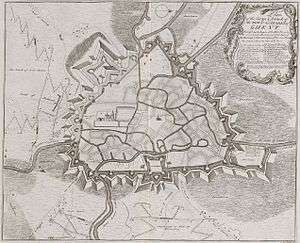Siege of Ghent (1708)
The Siege of Ghent (18–30 December 1708) was the last operation of the 1708 campaign season during the War of the Spanish Succession. After successfully taking Lille shortly before, the Duke of Marlborough moved his forces onto the town of Ghent where after a 12-day siege the town's governor, Count de la Motte, surrendered.
Background
The War of the Spanish Succession was triggered by the death of Charles II of Spain, who had no children. He left the Spanish throne to Philip of Anjou, a member of the French House of Bourbon, but the Archduke Charles of Austria also felt he had a claim to the throne. The Grand Alliance of Great Britain, the Dutch Republic, the Holy Roman Empire and Habsburg Spain, declared war on France and Bourbon Spain in May 1702.[1]
Prelude
During the 1708 campaign of the War, the Duke of Marlborough, commanding the Alliance's army in the Low Countries, planned with the Dutch commanders to move all of their forces to attack the French. They were caught by surprise when the French captured Ghent in July, gaining control of the Flanders waterways, and making it impossible for the Alliance to leave Brussels undefended. Marlborough recovered with victories over the French at Oudenarde and then laying siege to French-held Lille. Though Marlborough suffered huge losses during the siege, estimated to be around 15,000, he succeeded in taking Lille after 120 days, on 10 December 1708.[2]
Siege
The French, believing that the fighting had concluded for the winter, had broken their army up after the loss of Lille, but Marlborough decided to make one more push in an effort to retake Ghent. His army arrived in the town on 18 December, where they found a defence consisting of around 18,000 with instructions to defend the town to the last. The Alliance army had laid down its trenches by 24 December, and made a foray the following day which was driven back. On 28 December, the attackers had established their artillery, and bombarded the town with mortar. The Governor of Ghent, the Count de la Motte, sent out soldiers under a flag of truce, setting out terms of surrender unless a relieving force arrived by 2 January. As no such force appeared, he relinquished the town on that date to Marlborough. In a letter sent by Marlborough to the Secretary of State, Henry Boyle, he described it took the French defenders "from ten in the morning till seven at night" to evacuate the town.[3]
Aftermath
Bruges capitulated shortly thereafter, while the smaller garrisons of Plassendale and Leffinge were evacuated.[3] Only a few days after the capture of Ghent a harsh winter set in, described as "one of the most brutal in contemporary memory" by the historian Jamel Ostwald, and there was no further fighting in the Low Countries until the following June.[4]
References
- Suzanne Hiles Burkholder (2008). "War of the Spanish Succession". In Jay Kinsbruner; Erick D. Langer (eds.). Encyclopedia of Latin American History and Culture. 6 (2 ed.). Charles Scribner's Sons. pp. 414–415. Retrieved 3 September 2019.
- Hattendorf, John B (2014) [2004]. "Churchill, John, first duke of Marlborough". Oxford Dictionary of National Biography (online ed.). Oxford University Press. doi:10.1093/ref:odnb/5401. (Subscription or UK public library membership required.)
- Alison, Archibald (1848). The Military Life of John, Duke of Marlborough. Edinburgh and London: William Blackwood & Sons. pp. 235–236. OCLC 609238102.
- Ostwald, Jamel (2007). Vauban Under Siege: Engineering Efficiency and Martial Vigor in the War of Spanish Succession. Leiden and Boston: Brill. pp. 101–102. ISBN 978-90-04-15489-6.
